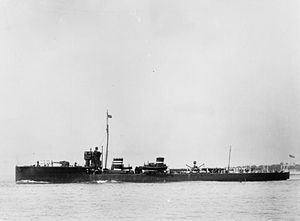Name HMS Lapwing Beam 26 ft (7.9 m) Installed power 13,500 shp (10,100 kW) Length 75 m Displacement 675,900 kg Builder Cammell Laird | Fate Sold 26 October 1921 Draught 9 ft (2.7 m) Launched 29 September 1911 Weight 757 tons Draft 2.7 m | |
 | ||
Class and type Acheron-class destroyer | ||
HMS Lapwing was an Acheron-class destroyer of the Royal Navy that served during World War I and was sold for breaking in 1921. She was the seventh Royal Navy ship to be named after Vanellus vanellus, the northern lapwing.
Contents
Construction
She was built under the 1910-11 shipbuilding programme by Cammell Laird and Company of Birkenhead. She had three Parsons turbines, and three Yarrows boilers. Capable of 27 knots, she carried two 4-inch guns, other smaller guns and two 21-inch torpedo tubes and had a complement of 72 men. She was launched on 29 September 1911.
Pre-War
Lapwing served with the First Destroyer Flotilla from 1911 and, with her flotilla, joined the British Grand Fleet in 1914 on the outbreak of World War I.
The Battle of Heligoland Bight
She was present with First Destroyer Flotilla on 28 August 1914 at the Battle of Heligoland Bight, led by the light cruiser Fearless, and shared in the prize money for the battle. When HMS Laertes was seriously damaged and stopped in the water, Lapwing went to her aid under heavy fire. Lieutenant Commander Gye manoeuvred to pass a tow, but in getting underway the towing hawser parted. Laertes was saved only by the arrival of the battle cruiser Lion.
The Battle of Dogger Bank
On 24 January 1915, the First Destroyer Flotilla, including Lapwing, were present at the Battle of Dogger Bank, led by the light cruiser Aurora. Her crew shared in the Prize Money for the German armoured cruiser Blücher.
The Battle of Jutland
Lapwing, under the command of Lieutenant-Commander Alexander Gye, was present with her flotilla at the Battle of Jutland on 31 May 1916.
Mediterranean Service
From 1917 the Third Battle Squadron was deployed to the Mediterranean. She later took part in the Battle of Jaffa and was present at the entry of the Allied Fleet through the Dardanelles on 12 November 1918.
Disposal
In common with the survivors of her class, she was laid up after World War I, and on 26 October 1921 she was sold to the Barking Ship Breaking Company for scrap.
